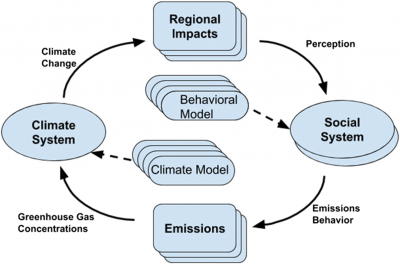The Earth Has Humans, So Why Don’t Our Climate Models?
An interdisciplinary working group—consisting of biologists, climate modelers, ecologists, mathematicians, and psychologists—came together to consider how to advance robust predictions at the intersection of climate models, Earth system models, and integrated assessment models by incorporating feedbacks of human social and behavioral systems. Early attempts to couple models of human behavior responses to climate change have demonstrated strong influences on greenhouse gas emissions mediated by human perception of risks, social learning, and social norms. The next step in developing social-climate models is to adopt a multi-model approach to examine the robustness of climate projects to choices of behavioral theory, alternative representations of social systems, and emissions behavior in response to climate impacts and perceived risks.
The authors describe the importance of linking social factors with climate processes and identify four priorities for advancing the development of coupled social-climate models: 1) evaluate an array of behavioral theories, 2) identify regional climate impacts on humans, 3) incorporate influence of diverse social systems, and 4) improve the representation of how perceptions and behavior influence greenhouse gas emissions. The complexity of human responses to climate change suggests the need for a Social Sciences Model Intercomparison Project (SMIP), akin to the Coupled Model Intercomparison Project (CMIP), that would focus on human social and behavioral systems.
While climate models have rapidly advanced in sophistication over recent decades, they lack dynamic representation of human behavior and social systems despite strong feedbacks between social processes and climate. The impacts of climate change alter perceptions of risk and emissions behavior that, in turn, influence the rate and magnitude of climate change. Addressing this deficiency in climate models requires a substantial interdisciplinary effort to couple models of climate and human behavior. The linking of social models with climate models would, for example, allow harmful changes in climate to lead to more aggressive improvements in energy efficiency and more rapid deployment of renewable energy systems, thereby reducing subsequent emissions and projected change in climate. Early efforts to couple social and climate models have demonstrated that social uncertainty in projections of climate change is potentially as large as the uncertainty in the physical climate system. The authors suggest a multi-model approach that considers a range of theories and representations of human behavior and social systems, similar to the multi-model approach that has been used to explore the physical climate system. They describe the importance of linking social factors with climate processes and identify four priorities essential to advancing the development of coupled social-climate models.

